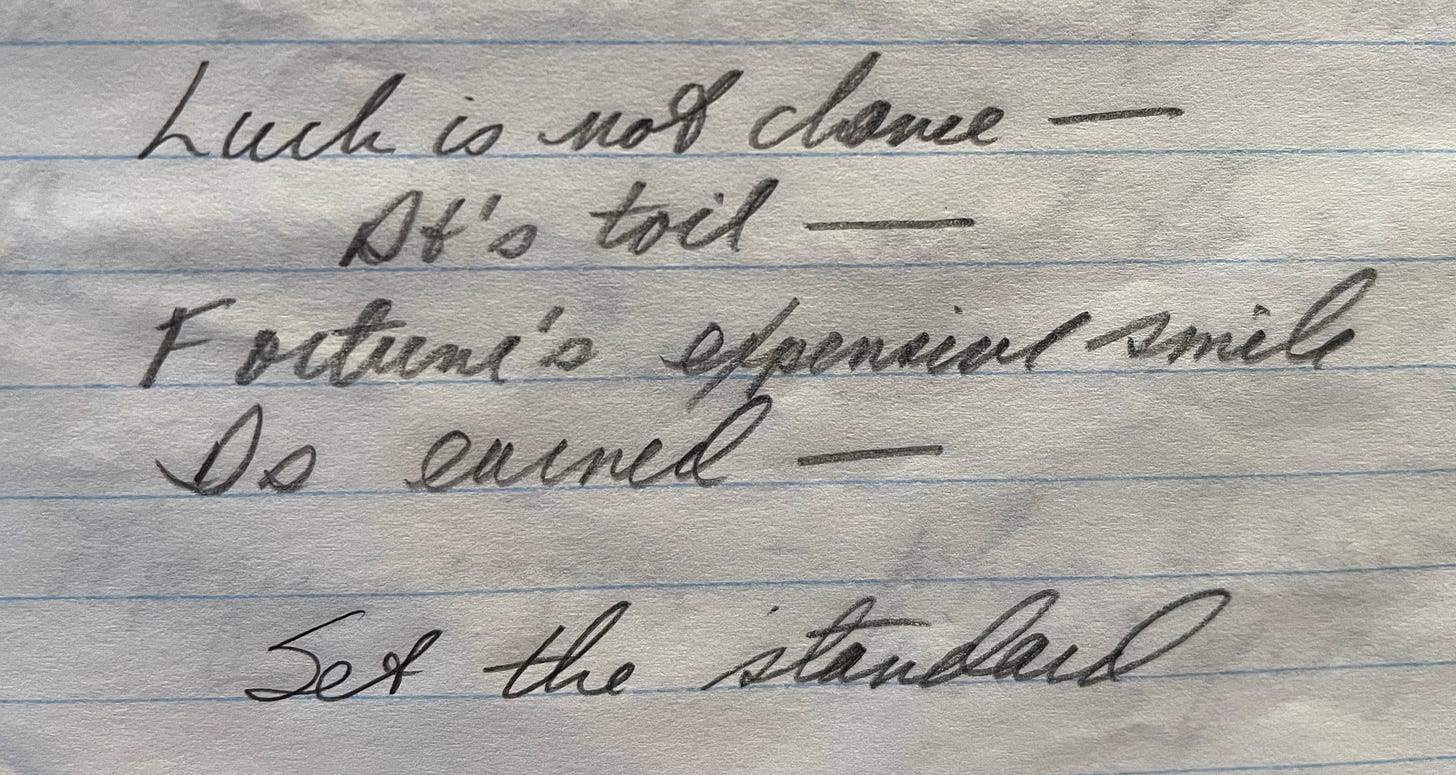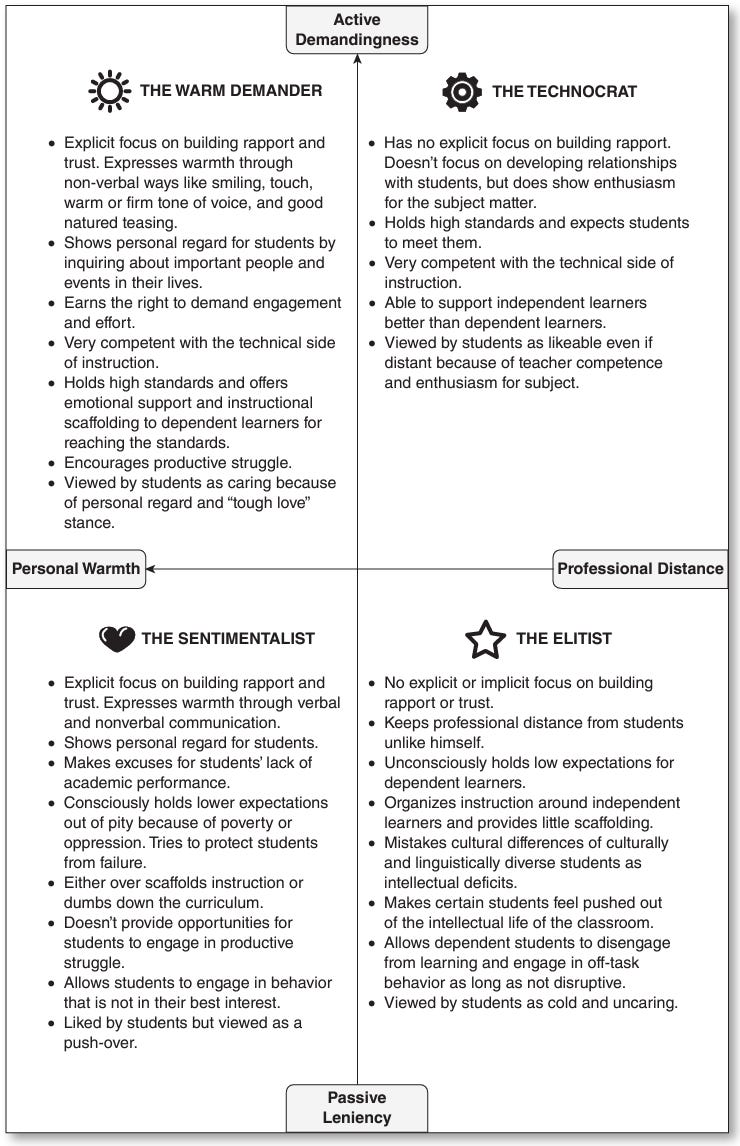The Warm Demander
10. “The best teacher in the world is someone who loves what he or she does, and just loves it in front of you.” - Fred Rogers
If you asked Margie the key to her teams’ success, without skipping a beat she’d say two things: the people and the practices. This post is about the practices. She believed it was her job to create an environment where athletes were challenged, had fun, and improved.
“What is a normal practice like?” was a common question posed by prospective student-athletes. Margie’s answer? “There’s no such thing as a normal practice.”
She spent a lot of time planning for practice, and she had a ton of fun running them. In fact, I’m not sure who enjoyed practices more, Margie or her players. She took an enormous of amount of pride in her practice planning and her teaching ability.
Margie would credit her time as an elementary school physical education teacher to be the key to her coaching success. The experience taught her the importance of being prepared, effective communication, and the power of enthusiasm. Her days involved switching from a class of first-graders to sixth-graders, back to a class of third-graders, and so on. She had to be nimble and make activities simple. Learning and improvements were the direct result of well-planned and engaging lessons which were transferable across the ages. Margie always thought if you could successfully juggle P.E. classes for children age 6-12, you could almost do anything! She didn’t know it at the time, but the experience and wisdom gained from teaching in an elementary school would bring her great success later in her coaching career.
Also, as a dual sport coach working year-round for more than 20 years, Margie gained a wealth of ‘coaching reps’. I think this matters. If it takes 10,000 hours to become an expert1, she became one in half the time. She honed her skills, at an accelerated pace, by coaching both volleyball and softball, and teaching P.E. classes. Margie accumulated lots of ‘coaching reps’ and ultimately sharpened her skills to end up as a master teacher.
Central Themes
Organized
Margie’s practices were meticulously planned. She did not want to waste time or have players standing in a line, waiting for their turn. Using stations and circuits, she kept everyone moving. There was always something to do. She even made a list of “Things To Do When There’s Nothing To Do” which consisted of creative activities you could do on your own: tossing pop-ups to yourself, catching the ball behind your back or between your legs, taking swings with a bat, and visualizing. Detailed practice plans often included maps and drawings to maximize time and keep everyone active. What could appear chaotic to the casual observer - people all over the field and beyond the fences, doing lots of different activities - was actually quite organized and disciplined.
Margie’s preparation sent a clear message: this is important and it matters. I read a quote the other day that made me think of her, “Good leaders view themselves as trustees of others’ time.2“ She knew the value of practice time and it was sacred. And she also valued our time as students and athletes, and she wasn’t about to waste it. We knew that she respected our time.
Margie believed the practice plan was the coach’s homework. Margie knew there were too many distractions during the day at work(paperwork, emails, players or other coaches popping in the office). For many years, she also taught classes in the Physical Education Department (for future P.E. teachers…how lucky were they?) which also took up a lot of time. So she always prepared for practice well in advance, so she could gave her undivided attention to those who came to see her during the day.
Intentional
Every rep is important. Each practice matters. Every game is the “big game”. There are no little things. Margie did not ignore the reality of playoff games or rivalry games, however she knew that every day was an opportunity to practice with intensity and intention. She made sure we were being purposeful and using these opportunities to get better. Gameday wins were the result of practice “wins”. You could not have one without the other.
Margie cared about technique and the most minute details of a swing or a throw. She was a motor learning expert, and she knew a seemingly small adjustment could have a big impact. She could watch a player having a catch and immediately identify ten things they could do better. She could see it, filter it through her ‘coaches eye’, and deliver constructive feedback in such a way that her players knew they would improve.
Fun
Margie never took herself too seriously. She would come in costume and do silly things, ROUTINELY…whatever it took to make practices fun. When a coach is fully present and playful, the players will follow suit. Her sense of humor and willingness to laugh at herself, invited you to join in the fun.
She would often say “Celebrate the little victories or you’ll never get the big ones.” It is sometimes hard to see “learning” as it is happening. One of her biggest thrills as a coach was seeing her athletes get better. It is fun and encouraging to get better. It is the most fun to see and feel progress.
Challenging
While everyone remembers practices fondly, I don’t believe anyone would say they were easy; mentally or physically. She had a knack for hitting that sweet spot of pushing just the right amount; not so much that we were demoralized, and not too little so that it was a breeze. Effort level was a non-negotiable for Margie. She would never allow us to settle for less than our best.

I recently learned an education term that perfectly described Margie and this balance I’m referring to: Warm Demander was coined by educator Judith Kleinfeld in 1975. (1975?! How have I not heard of this?) Kleinfeld defined a Warm Demander as, “the combination of high expectations for (academic) performance….and supportive instrumental relationships between the students and the teacher.”3 Later, Lisa Delpit described the term by saying, “they expect great things from their students, convince them of their own brilliance, and help them reach their potential in a structured, disciplined environment.”4. “Convince them of their own brilliance.” THAT was Margie.

Margie taught with a warmth and authenticity that was powerful. She would, lovingly, hold you to a high standard. It was both scary and fun at the same time. As a player you knew practices would be challenging and exciting, AND you knew there were high expectations and consequences if those expectations were not met. It could produce anxiety. Margie would say, “the big moments in games could produce anxiety too, so let’s practice it!”
This topic is complex and nuanced. I will discuss the specifics of Margie’s teaching magic in future posts. There’s so much to say. Gosh, I wish I could chat with Margie about this “warm demander” concept and how it shows up in coaching. We would have totally geeked out over this. How can we use this in a practice? Where are we on the warm demander chart? How could this help us get better? Are we more ‘warm’ or more ‘demanding’?
This would have been a great conversation and when it ended, Margie would exclaim, as she so often did, “This should have been a podcast!”, and we would laugh. And here I am now…sharing with you via this platform. Our podcast on a page.
Bob Sutton, Stanford School of Business, Workplace Friction
“Becoming a Warm Demander”, by Zaretta Hammond, in Culturally Responsive Teaching and the Brain, page 97
The Warm Demander, An Equity Approach, Edutopia, Learn More Here





